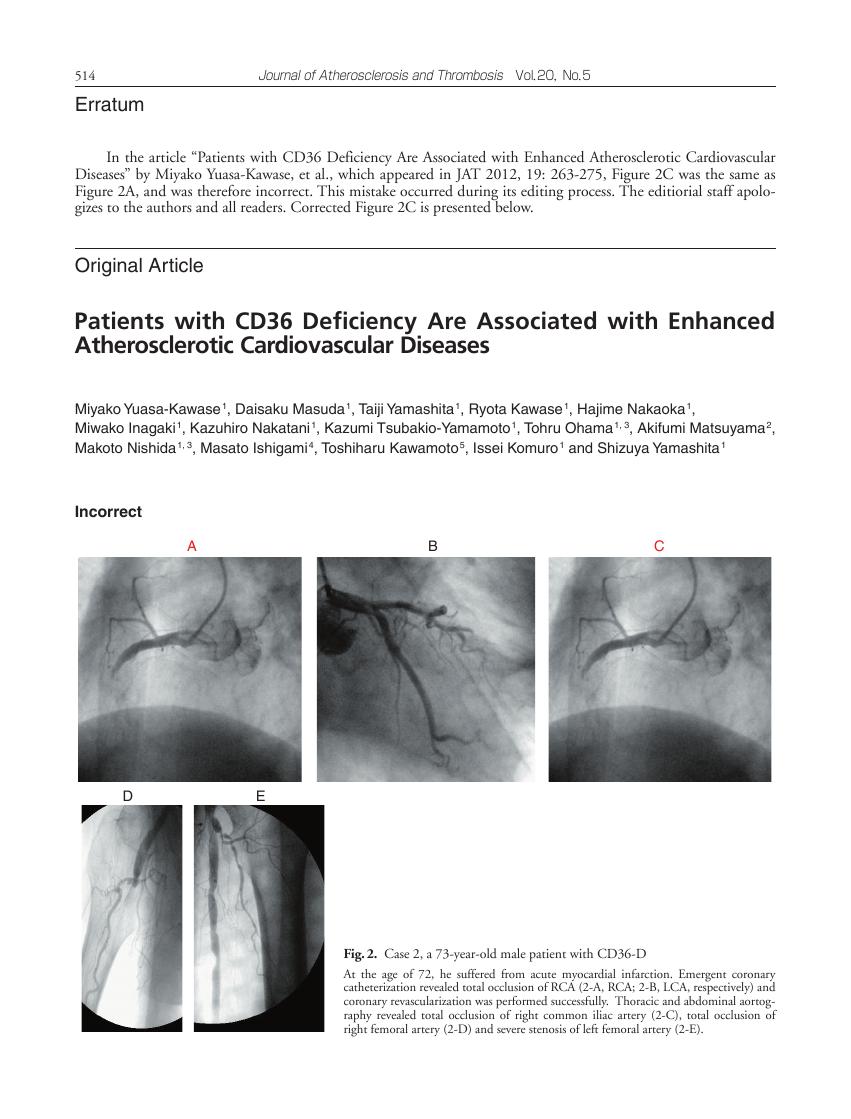4 0 0 0 OA Patients with CD36 Deficiency Are Associated with Enhanced Atherosclerotic Cardiovascular Diseases
- 著者
- Miyako Yuasa-Kawase Daisaku Masuda Taiji Yamashita Ryota Kawase Hajime Nakaoka Miwako Inagaki Kazuhiro Nakatani Kazumi Tsubakio-Yamamoto Tohru Ohama Akifumi Matsuyama Makoto Nishida Masato Ishigami Toshiharu Kawamoto Issei Komuro Shizuya Yamashita
- 出版者
- 一般社団法人 日本動脈硬化学会
- 雑誌
- Journal of Atherosclerosis and Thrombosis (ISSN:13403478)
- 巻号頁・発行日
- vol.19, no.3, pp.263-275, 2012 (Released:2012-03-26)
- 参考文献数
- 48
- 被引用文献数
- 9 32
Aim: The clustering of dyslipidemia, impaired glucose tolerance and hypertension increases the morbidity and mortality from cardiovascular events. A class B scavenger receptor, CD36, is a receptor for oxidized LDL and a transporter of long-chain fatty acids. Because of the impaired uptake of oxidized LDL in CD36-deficient macrophages and from the results of CD36 knockout mice, CD36 deficiency (CD36-D) was supposed to be associated with reduced risks for coronary artery disease (CAD); however, CD36-D patients are often accompanied by a clustering of coronary risk factors. The current study aimed to investigate the morbidity and severity of cardiovascular diseases in CD36-D patients.Methods: By screening for CD36 antigen on platelets and monocytes using FACS or the absent myocardial accumulation of 123I-BMIPP by scintigraphy, 40 patients with type I CD36-D were collected, the morbidity of CAD and their features of atherosclerotic cardiovascular diseases were observed. Screening for CD36-D in both CAD patients (n =319) and healthy subjects (n =1,239) were underwent.Results: The morbidity of CAD was significantly higher in CD36-D patients than in the general population; 50% of patients (20 out of 40) had CAD identified by BMIPP scintigraphy and 37.5% (3 out of 8) by FACS screening, respectively. Three representative CD36-D cases demonstrated severe CAD and atherosclerosis. The frequency of CD36-D was three times higher in CAD patients than in healthy subjects (0.9% vs 0.3%, p <0.0001).Conclusion: The morbidity of CAD is significantly higher in CD36-D patients suffering from severe atherosclerosis, implying that the status of CD36-D might be atherogenic.
2 0 0 0 OA Patients with CD36 Deficiency Are Associated with Enhanced Atherosclerotic Cardiovascular Diseases
- 著者
- Miyako Yuasa-Kawase Daisaku Masuda Taiji Yamashita Ryota Kawase Hajime Nakaoka Miwako Inagaki Kazuhiro Nakatani Kazumi Tsubakio-Yamamoto Tohru Ohama Akifumi Matsuyama Makoto Nishida Masato Ishigami Toshiharu Kawamoto Issei Komuro Shizuya Yamashita
- 出版者
- 一般社団法人 日本動脈硬化学会
- 雑誌
- Journal of Atherosclerosis and Thrombosis (ISSN:13403478)
- 巻号頁・発行日
- vol.20, no.5, pp.514-515, 2013 (Released:2013-05-29)
- 参考文献数
- 48
- 著者
- Shizuya Yamashita Hidenori Arai Hideaki Bujo Daisaku Masuda Tohru Ohama Toshiyuki Ishibashi Koji Yanagi Yasuji Doi Satoshi Nakagawa Koichi Yamashiro Kenichiro Tanabe Toru Kita Masunori Matsuzaki Yasushi Saito Masanori Fukushima Yuji Matsuzawa on Behalf of the PROSPECTIVE Study Group
- 出版者
- Japan Atherosclerosis Society
- 雑誌
- Journal of Atherosclerosis and Thrombosis (ISSN:13403478)
- 巻号頁・発行日
- pp.55327, (Released:2020-04-24)
- 参考文献数
- 50
- 被引用文献数
- 26
Aims: Although intensive statin therapy reduced cardiovascular risks, cardiovascular events have not been completely prevented. Probucol is a potent antioxidant and reduces tendon xanthomas in familial hypercholesterolemia patients despite reduction of high-density lipoprotein (HDL)-cholesterol (HDL-C). We investigated whether probucol can reduce cardiovascular events on top of conventional lipid-lowering therapy in patients with coronary heart disease (CHD). Methods: PROSPECTIVE is a multicenter, randomized, prospective study that recruited 876 Japanese patients with CHD and dyslipidemia with an low-density lipoprotein (LDL)-cholesterol (HDL-C) level of ≥ 140 mg/dL without medication or those treated with lipid-lowering drugs. Lipid-lowering agents were administered during the study period in the control group (n=438), and probucol 500 mg/day was added to lipid-lowering therapy in the probucol group (n=438). Patients were randomly assigned to two treatment groups by adjusting the LDL-C level and presence of diabetes and hypertension and followed up for more than 3 years. The primary end point was a composite of cerebrovascular and cardiovascular events (cardiovascular disease death including sudden death, nonfatal myocardial infarction, nonfatal stroke, hospitalization for unstable angina, hospitalization for heart failure, or coronary revascularization). The secondary end point was carotid intima–media thickness in a subset of patients. Results: The incidence of the primary end point showed a trend to be lower in the probucol group compared with that in the control group despite reduced HDL-C without serious adverse events. Anti-atherogenic effects of probucol may be attributed to its potent antioxidative function and enhancement of reverse cholesterol transport. Conclusion: Since there was no statistical significance between the probucol and control groups despite a marked reduction of HDL-C, further studies on the clinical outcomes of probucol on top of conventional therapy may be necessary in the future (UMIN000003307).
- 著者
- Kaori Nakanishi Makoto Nishida Tohru Ohama Toshiki Moriyama Keiko Yamauchi-Takihara
- 出版者
- 日本循環器学会
- 雑誌
- Circulation Journal (ISSN:13469843)
- 巻号頁・発行日
- pp.CJ-13-1134, (Released:2014-03-11)
- 参考文献数
- 33
- 被引用文献数
- 5 21
Background: Smoking and metabolic syndrome (MetS) are major public health problems in modern society and are important risk factors of cardiovascular disease (CVD). The association of smoking, MetS, and CVD is widely reported, but reports targeted to women are few. In the present study, we evaluated risk factors, including visceral fat area (VFA), for CVD and development of subclinical atherosclerosis in female smokers especially. Methods and Results: Subjects consisted of 162 apparent healthy female and male smokers, and 315 age-matched never-smokers who underwent a health examination in the Osaka University Health Care Center. For female smokers, lifestyle and carotid intima-media thickness (IMT) were evaluated. Triglycerides were significantly higher and high-density lipoprotein-cholesterol significantly lower in smokers than in never-smokers for both men and women. However, VFA was significantly high only in smoking women when compared with never-smokers. Multivariate analysis revealed that age, body mass index, and smoking were the independent predictors of high VFA in women. In addition, annual IMT increase was significantly higher in smokers than never-smokers in women. Conclusions: VFA was notably high in female smokers, but the difference was not observed in men. Smoking habit is an important risk factor of visceral fat accumulation and progression of subclinical atherosclerosis in women.
